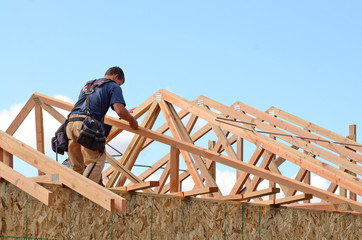Advantages of Steep-Sloped Residential Roofing

Roofing is an essential part of your home. Roofing Killeen TX protects your house and keeps it warm, dry, and comfortable. There are many residential roof materials, each with its benefits. But before you make a final decision, you should consider some key factors:

Steep-sloped roofs are popular for residential roofing because they offer many advantages. These include cost-effectiveness, longevity, and maintenance. A steep sloped roof can help keep leaves, twigs, and branches from collecting on the roof edge. They also help keep your home looking tidy and pristine all year round.
Those things often collect and build up on low-sloped roofs, which makes cleaning them more difficult. Those leaves can even cause rotting tree needles to collect, which may make the roof look unkempt and messy.
In contrast, a steep-sloped roof sheds water and debris more easily because gravity pulls the debris away from the surface of the roof. This prevents the build-up of a puddle of water on the roof that can lead to dangerous leaks and damages to your home.
In addition, a steep sloped roof can help to prevent snow accumulation because it encourages snow and ice to melt away before they build up. This helps to prevent ice dams that can damage your roof and gutters.
Whether you are building your new home or replacing your old roof, residential roofing is one of the most cost-effective ways to improve your property’s overall appearance. It can add value to your property and make your home more appealing to potential buyers.
A new roof can also save you money in the long run because it reduces your energy expenses. In fact, a roof that is made from high-quality materials can help to insulate your home against heat, which means you’ll have lower heating and cooling bills.
You can choose from a variety of roofing materials, including asphalt shingles, tiles and metal roofing. Choosing the right material will have a significant impact on the cost of your roofing project.
A roof’s lifespan depends on a number of factors, including the type of material it’s made from and the climate and region in which it was installed. It’s also important to consider the resale value of your property and how long you plan to live there.
Wood shingles and shakes, for example, usually last around 25 years. However, their lifespan can be shortened by extreme temperatures, damp climates, and lack of maintenance.
Concrete tiles, on the other hand, typically last 50 years or more under ideal conditions with little maintenance. They’re heavy, though, so they require additional reinforcement to install them.
Slate tile roofing is another option that holds up well under harsh weather conditions and temperatures. Depending on the type of slate, you can expect it to last anywhere from 50 years to 150 years.
Asphalt shingles are the most common roofing material in the United States. They typically last 15 to 30 years, but can last even longer with proper maintenance and upkeep.
Roofing systems require ongoing maintenance to remain in good condition. Regular inspections by a professional roofer are the best way to keep your roofing system in tip top shape and to catch small problems before they become major ones.
A roof maintenance plan will help postpone the need for roof replacement and can save you money on long-term repair costs. It also allows you to keep your warranty valid.
To protect your roof from potential damage, it’s a good idea to clear away debris such as branches and leaves. Allowing these to build up on your roof restricts drainage and can accelerate membrane deterioration.
In addition, if you’re planning on selling your home, it’s important to keep in mind that most brands will nullify warranties if you fail to maintain your roof. Having routine, bi-annual inspections will help you avoid these problems. And if you have insurance, having a history of maintenance photos will help you get reimbursed when filing a claim.
If you’re a roofing enthusiast and want to start your own business, there are three main options: work for someone else, form a company of your own, or work as a freelancer. As you may expect, there are pros and cons to each. Here are a few tips to consider before deciding.
The first thing to do is to figure out what your main product or service is. This will determine which kind of business entity will suit you best. Choosing a business entity is one of the most important decisions you’ll make, since it will affect your tax obligations, liability for business debts, and operating requirements.
